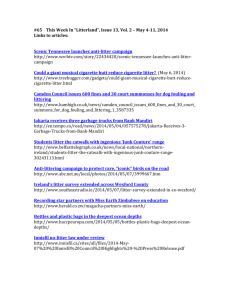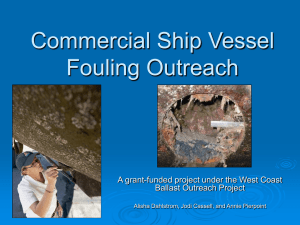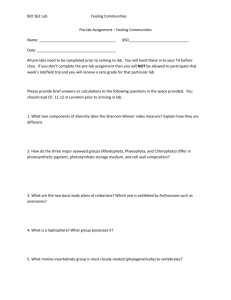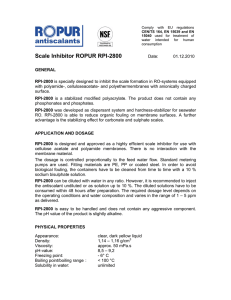Reducing Operating Costs with Optimal Maintenance Scheduling
advertisement
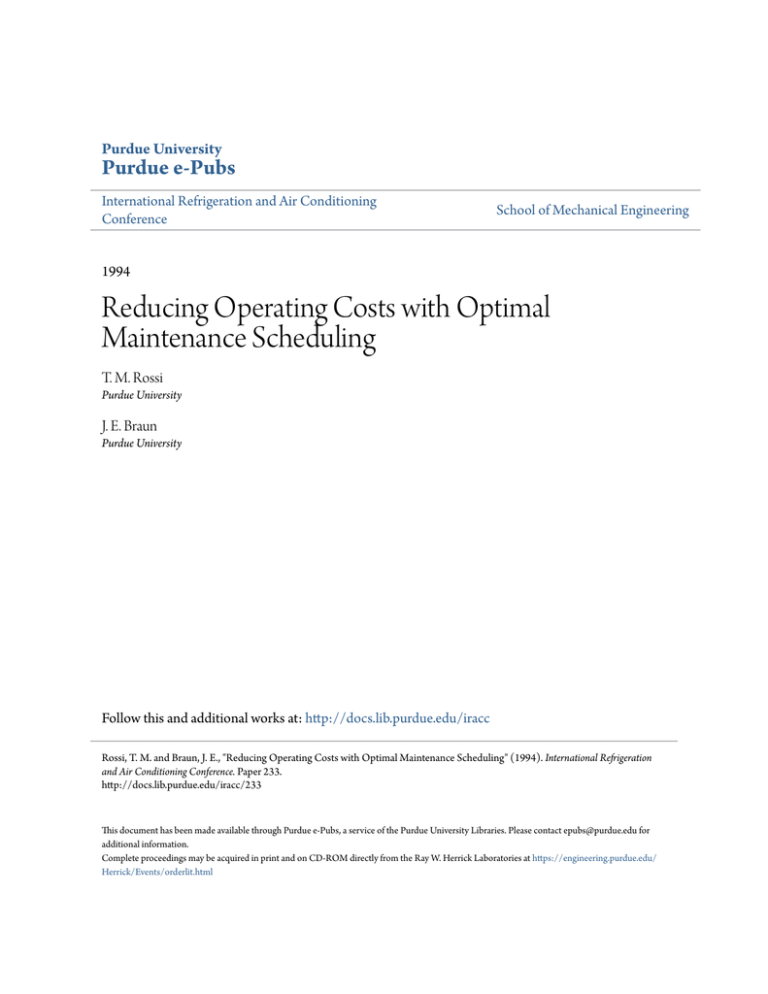
Purdue University
Purdue e-Pubs
International Refrigeration and Air Conditioning
Conference
School of Mechanical Engineering
1994
Reducing Operating Costs with Optimal
Maintenance Scheduling
T. M. Rossi
Purdue University
J. E. Braun
Purdue University
Follow this and additional works at: http://docs.lib.purdue.edu/iracc
Rossi, T. M. and Braun, J. E., "Reducing Operating Costs with Optimal Maintenance Scheduling" (1994). International Refrigeration
and Air Conditioning Conference. Paper 233.
http://docs.lib.purdue.edu/iracc/233
This document has been made available through Purdue e-Pubs, a service of the Purdue University Libraries. Please contact epubs@purdue.edu for
additional information.
Complete proceedings may be acquired in print and on CD-ROM directly from the Ray W. Herrick Laboratories at https://engineering.purdue.edu/
Herrick/Events/orderlit.html
REDUC ING OPERA TING COSTS
WITH OPTIM AL MAINT ENANC E SCHED ULING
Todd M. Rossi and James E. Braun
Ray W. Herrick Laboratories, Purdue University
West Lafayette, IN 47907-1077, USA.
ABSTRA CT
The potential benefits of optimal service scheduling for cleaning heat exchangers based
on minimizing operating costs are explored. A demonstrat ion is performed on a simulated
20 ton air-to-air vapor compression air conditioner. The costs of regular service schedules
(indicative of current practice), minimal schedules needed to maintain comfort, and the
optimal schedules are compared. Generally, the minimum comfort schedules have costs
between the regular and optimal schedules. The comfort schedules cost as much as 4.2%
more than the optimal, the difference increasing with increasing fouling time. Regular
(annual) service was as much ·as 11.7% more expensive than optimal for the range of
conditions tested. Results are shown for evaporator and condenser fouling and for two
different cooling capacity to building load ratios.
1
INTRODU CTION
Automated fault detection and diagnosis has the potential to reduce down time and operating
costs in HVAC&R equipment. There are a large variety of techniques that compare observation s with
model predictions to detect and diagnose abnormal behavior. In a general sense, these techniques
generate residuals representin g the difference between observed and expected performanc e. Classifiers
then operate on the residuals and return decisions indicating when the equipment is malfunction ing and
its cause( s ). The most challenging aspect of classifier design is determining the boundaries between
various classes (e.g. fault /no fault). There are well established techniques derived from statistical
pattern recognition application s for determining the optimal boundaries based on minimizing the
probability of making erroneous decisions (Bayes classifier). These methods determine thresholds
based on the statistical properties of training data.
There are two types of malfunctions: hard faults and performanc e degradation s. Hard faults
are sudden and abrupt changes such as motor failures and broken belts. They are relatively easy to
classify because it is simple to find a residual for which the fault and no fault classes are well separated.
Performanc e degradation s are malfunction s that become progressively worse in a continuous sense
(e.g. heat exchanger fouling). In this case, it becomes difficult to define when the malfunction is bad
enough to justify the repair expense. It is possible to define four criteria for servicing performanc e
degradation s in HVAC&R equipment: (1) economics, (2) comfort or refrigeratio n requiremen ts, (3)
equipment safety, and (4) environmen tal hazard. The economic criteria prescribes service when it
103
reduces or minimizes overall lifetime operating costs. The comfort criteria calls for service when design
objectives are not satisfied. The equipment safety criteria detects operating states that wear expensive
components prematurely (e.g. liquid entering a reciprocating compressor). Finally, the environmental
hazard criteria searches for malfunctions that pollute or harm the environment (e.g. refrigerant leaks).
It is the goal of this paper to investigate optimal maintenance scheduling for cleaning evaporator
coils (or changing filters) and condenser coils based on an economic criteria. The optimal maintenance schedule minimizes overall lifetime operating costs including energy, service, and downtime (not
considered here). The main points considered in this paper are: (1) the potential financial benefits
of optimal decision making vs. current state of the art (e.g. regular service schedules), and (2) the
conditions for which service is based on an· economic rather than comfort criteria. These insights are
obtained by operating an optimal decision maker on a simulated building.
OPTIMAL SOLUTION
2
The optimal service schedule is obtained by minimizing the time averaged combined cost of
service and energy over the lifetime of the equipment.
J
=
1 fTl
Tt
lo
(Energy cost
+
Service cost) dt
where Tt is the equipment lifetime. When service is performed too often, excess service costs increase
J, and when service is too infrequent excess energy costs control J. Assume that there exists a periodic
service schedule (allowing simple extrapolation for Tz --!' oo) that minimizes J and that the costs of
energy and service are constants. Therefore,
J
=
(1)
where Tis the period of the service cycle, Ce is the cost of energy, Cs is the cost of service, T is the set
of times, { T 1 , T 2 , .•... , TN}, that each of N service tasks are performed, P is the instantaneous power
consumption of the equipment, i(t) represents the driving functions controlling power consumption
including ambient and return air temperature and humidity, f is the state of fouling of the heat
exchangers, ton= <j>t- T; (where</>= 0/1 (fan ofi'jon)) is the fan run-time since last cleaning, tf is the
characteristic fouling time of the heat exchangers, and 8(t- T;) is the Dirac delta or impulse function.
A building model defines the driving functions i(t), a fouling model determines the fouling schedule f(t 0 n, tf ), and a steady state vapor compression refrigeration cycle model defines P(i(t), f(t 0 n, t1 ))
each of which are described in the next section. The goal of the optimization algorithm is to determine,
for given Cs/Ce and tf, the values ofT, N, and {T1, T2, .••.. , TN} (defining the service schedule) that
minimizes J subject to a comfort constraint. The problem is simplified by only allowing service at
fixed time intervals (e.g. one month). Dynamic programming [Bellman 1957] is then used to determine
the times to perform service that minimizes the cost function.
104
0.25
~
-
0.9
-
0.8
0.7
0.2
-~
"30.6
"'
,---
0
0
"'
go.s
0
.5
~0.15
1
"~
0
~
i') 0.4
,---
:I:
0. 1
0.3
..:;:
o_o 5
0
2
n
4
6
8
Month of the Year
n
10
0.2
0.1
12
B"2
243
249
(b)
(a)
Figure 1: Cooling load schedule for demonstration building (normalized by the peak load): (a) Average
monthly cooling load, (b) hourly cooling load for one week surrounding the peak load day.
3
CONDITIONS OF DEMONSTRATION
Building cooling requirements were determined using a TRNSYS simulation [Klein et al. 1990]
of a three zone office building in Nashville, TN, USA. The simulation considered detailed features
including real typical meteorological year (TMY) weather data [Hall, Prairie, Anderson & Boes 1978],
coupling to the ambient (temperature and humidity), internal and solar gains, building mass, weekday
and weekend occupancy schedules, and night setback control. The cooling load for every hour of a
typical year was provided by the simulation. Fig. 1 shows the average monthly cooling load for one
year and the hourly cooling load for a one week period surrounding the peak cooling load day.
The building was cooled by an air-to-air vapor compression air conditioning system using onjoff
control. A detailed physical model was used to predict the performance of a commonly available
commercial air conditioning system. It determined the power consumption and cooling capacity based
on outdoor drybulb, indoor wetbulb, evaporator filter fouling state, and condenser fouling state. For
simplicity, fouling was modeled only as an obstruction to air flow across the coils (a better assumption
for dirty filters than fouled coils). The state of fouling was defined as the ratio of the air mass flow rate
to the value for a clean coil. (O=completely obstructed and l=no obstruction or clean). A simulation
was run over an uniformly spaced four dimensional grid ofthe independent variables, 0°Cs; Tout s; 45°C
(outside drybulb), l3°Cs; Tins; 36.5°C (inside wetbulb), 2.0kgs- 1 m- 2 s; Gouts; 7.0kgs- 1 m- 2
(outside air mass flux), 0.4kgs- 1 m- 2 s; Gins; 2.0kgs- 1 m- 2 (inside air mass flux), and then the
results were inserted into a four dimensional linear lookup table for power consumption and capacity.
The lookup table was then used by the optimal scheduling program to determine the amount of energy
used to support the prescribed cooling load under the specified conditions and fouling states.
For simplicity, fouling was modeled as a linear function of fan run-time. It increased from 0, after
cl~aning, to 1 in a characteristic time t J. The fans ran only during a call for cooling. An artificially
large cost penalty was assigned for operation of the unit for fouling beyond the maximum considered
105
by the air conditioner model (0.7p for the evaporator and 0.71 for the condenser) and when there was
not enough capacity to meet the required load. The minimum fan run-time, which would occur if
there were no fouling, was one month per year. As capacity decreased with fouling, added run-time
was required to meet the load.
4
RESULTS
Fig. 2 shows the additional costs (service + energy) associated with fouling normalized by the
minimum cost (energy only, no fouling) vs. the characteristic fouling time for evaporator and condenser
fouling. The results are shown for two different cooling capacity to building load ratios defined by
the part load fraction at maximum cooling load with no fouling (PLFmax)· For PLFmax = 0.94,
the minimum cost is $1206.65 and there is less extra capacity than for PLFmax = 0.57 where the
minimum cost is $735.76. The nominal capacity of the unit is 20 tons, Ce = 0.10$/kWh, Cs = $100
for condenser cleaning, and Cs = $60 for evaporator cleaning or filter changing. In the regular service
schedule, evaporators and condensers are serviced annually. For short fouling times, regular service
may be supplemented when required to maintain comfort. The comfort schedule shows the operating
costs when the minimum service required to maintain comfort is performed.
Consider the effects of evaporator fouling. When the air conditioner has little extra cooling
capacity (fig. 2a), the optimal and comfort solutions are the same. This indicates that evaporator
fouling has a large impact on cooling capacity. When there is extra capacity (fig. 2c), less service is
required to maintain comfort and there is potential to save money through additional service at the
correct times as indicated by the optimal schedule. In the case of condenser fouling, the difference
between the comfort and optimal solutions is not sensitive to available capacity (fig. 2b & fig. 2d).
When condensers foul, capacity does not degrade appreciably, but head pressure rises, thereby driving
up cost. In general, the optimal and comfort curves are asymptotically approaching zero as the
fouling time increases because the additional costs associated with fouling are going to zero. The
regular schedule is approaching the normalized annual service cost that is wasted when there is no
fouling. For short fouling times, all three curves come together because service is controlled by the
comfort constraint. Regular service is excessive for most fouling rates and can be as high as 11.7%
above the optimal for t f = 2.0 years in fig. 2d. This may indicate that regular schedules are chosen
conservatively to counteract the reality that service is done less frequently than advised. The comfort
schedule performs better than the regular schedule in most cases, with a maximum of 4.2% above the
optimal for tf = 2.0 years in fig. 2d. This suggests that simple comfort control of service may provide
adequate performance for a simple fault detection system. Small irregularities of the data are caused
by numerical limitations including limited cycle lengths and segment sizes.
Fig. 3 shows the annual cost savings for optimal service scheduling as compared with regular
schedules vs. fouling time for different service costs and for P LFmax = 0.69. To provide a reference
point, the annual operating cost with no fouling is $882.91. For condenser fouling, the minimum
savings occurs at t t=l.5 months. Zero potential savings means that annual service is optimal for this
fouling time. As the fouling time increases, annual service is too much and there is savings associated
with doing less service. In the limit as t f -+ oo, the savings approach the money spent on service
in one year. As the fouling time decreases, the regular schedule is no longer capable of maintaining
comfort; supplemental service is added, hence, driving up costs. The trends for evaporator fouling are
similar.
106
0.2
0.2
•
0.18
X
0
Regular
Comfort
Optimal
•
0.18
0.16
0.16
0.14
0.14
0.12
0.12
0.1
0.1
o.oa
0.08
p
Regular
Comfort
Optimal
1.6
l.B
•
9
Regular
Comfort
Optimal
1.6
1.8
X
0.06
0.04
0.02
0.02
00
0.2
0.4
0.6
1
0.8
1.2
Fouling T1me (years)
1.4
1.6
1.8
00
2
0.2
0.4
0.6
0.8
1
1.2
Fouling Time (years)
(a)
2
(b)
0.2
0.2
•
0.18
X
0
0.16
Regular
Comfort
Optimal
0.18
X
0.16
E
E
-~ 0.14
'E 0.14
::i
::!
E
-; 0.12
!0.12
~
0.1
-.; 0.1
... 0.08
...!5 0.08
...-.;
"'
"'o;
o;
0
0
(J
(J
0::
:g0 0.06
:g 0.06
~
~
0.04
0.04
0.02
0.02
0
0
1.4
0.2
0.4
0.6
1
1.2
0.8
Fouling Time (years)
1.4
1.6
1.8
00
2
0.2
0.4
0.6
0.8
1
12
1.4
2
Fouling Time (years)
(c)
(d)
Figure 2: Additional annual operating cost (actual cost · minimum cost) normalized by the minimum
operating cost (energy only, no fouling) vs. characteristic fouling time ( t f) for (a) evaporator fouling
PLFmax = 0.94, (b) condenser fouling PLFmax = 0.94, (c) evaporator fouling PLFmax = 0.57, and
(d) condenser fouling P LFmax = 0.57. The minimum costs are $1206.65 for P LFmax = 0.94 and
$735.76 for P LFmax = 0.57.
107
eo
400
Sel'llice Cost: S400
350
70
€
e
a
E.
:0250
1i! 50
=
.5"' 300
Sal'lliCe Cost $100
~ 60
0
0
"5
$80
"
"'
a::"
8!."'
;200
a
$200
i5
$60
;4o
11;
il
830
0150
..:
~
$40
8.
0
0
1100
m20
"$100
"
0::
..:
~
$60
$.20
10
50
$20
00
0.6
o.e
1
1.2
Fouling Time (years)
1.~
1.6
1.6
2
00
1.2
1
0.6
Fouling Time (years)
1.4
1.6
1.8
2
(b)
(a)
Figure 3: Difference in annual operating cost between optimal service and regular service schedules
for (a) condenser fouling and (b) evaporator fouling.
5
CONCLUSIONS
The benefits of optimal service scheduling for cleaning heat exchanges based on mm1m1zmg
operating costs has been considered. Annual savings of up to 11.7% were shown when compared with
regular service schedules. This figure was sensitive to the choice of regular schedule, and since, for
most of the fouling times considered, regular service was excessive, a more frequent regular schedule
(e.g. quarterly) would indicate greater savings potential for these fouling times. Costs have also
been compared to the minimum service schedule required to maintain comfort and the difference is
never greater than 4.2% for the conditions studied. These results suggest that basing condenser and
evaporator service on comfort requirements works better than regular service, and therefore may be a
possible strategy for a simple fault detection system. However, additional cost savings are possible if
a practical method for minimizing costs in the field can be developed.
References
Bellman, R. E. [1957]. Dynamic Programming, Princeton University Press, Princeton, New Jersey.
Hall, I., Prairie, R., Anderson, H. & Boes, E. [1978]. Generation of a typical meteorological year, Proc.
of 1978 Annual Meeting, American Section of ISES, Denver 2(2): 669.
Klein, S. A. et al. [1990]. TRNSYS A transient system simulation program, 13.1 edn, Solar Energy
Laboratory, University of Wisconsin - Madison, Madison, WI.
108

